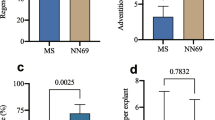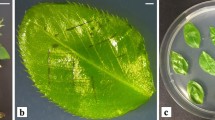Abstract
During gene transfer in apple, optimization of antibiotics concentration in post co-cultivation process is critical for the establishment of an efficient transformation system. Keeping in view, the doses of kanamycin (5–25 mg/l) and cefotaxime (100–500 mg/l) alone or in combinations were evaluated for their effects on callus induction and shoot regeneration. Cefotaxime at 100–500 mg/l was also tested for the inhibition of Agrobacterium tumefaciens strain EHA105 following co-cultivation with leaf explants of apple cv. Red Chief. In this study, leaf explants were found highly sensitive to kanamycin, a widely used antibiotic in transformed plant selection and recovery of transgenic plants. Low kanamycin doses of 5–8 mg/l resulted in callus induction and shoot regeneration. Maximum shoot regeneration frequency (60.56%) was obtained on 5 mg/l kanamycin and gradually reduced (12.84%) upto 8 mg/l. It reduced callus induction, completely inhibited the regeneration at 9–25 mg/l and developed chlorosis of leaves. Cefotaxime at 100–200 mg/l enhanced the regeneration rate (95–100%) from leaves comparable to control while higher concentrations gradually reduced the frequency of regeneration with decreased number of shoots per explant. However, no callus and regeneration were observed when kanamycin was combined with cefotaxime at various concentrations. Omission of kanamycin from initial regeneration phase for few days resulted in shoot induction. To eliminate the Agrobacterium overgrowth from cultured leaves, 500 mg/l cefotaxime was found effective. As this concentration inhibited the shoot induction, it was gradually reduced to 200 mg/l over a period of 7 weeks, which stimulated morphogenesis and later formed shoots. Thus, the optimized doses established in the present study could be applicable to suppress the excess Agrobacterium growth and to generate transformed shoots in further genetic transformation work on ‘Red Chief’.




Similar content being viewed by others
References
Alsheikh, M., Suso, H. P., Robson, M., Battey, N., & Wetten, A. (2002). Appropriate choice of antibiotic and Agrobacterium strain improves transformation of antibiotic sensitive Fragaria vesca and F. v. Semperflorens. Plant Cell Reports, 20, 1173–1180. https://doi.org/10.1007/s00299-002-0453-0
Chauhan, A., & Modgil, M. (2016). Phytotoxic effects of different antibiotics on leaf explants and their potential as Agrobacterium counter selection agents during gene transfer in apple. Indian Journal of Horticulture, 73, 287–290. https://doi.org/10.5958/0974-0112.2016.00062.1
Dai, H., Li, W., Mao, W., Zhang, L., Han, G., Zhao, K., Liu, Y., & Zhang, Z. (2013). Development of an efficient regeneration and Agrobacterium-mediated transformation system in crab apple (Malus micromalus) using cotyledons as explants. In Vitro Celullular and Developmental Biology-Plant, 50, 1–8. https://doi.org/10.1007/2Fs11627-013-9544-6
De Bondt, A., Eggermont, K., Druart, P., De Vil, M., Goderis, I., Vanderleyden, J., Broekaert, W. F. (1994). Agrobacterium-mediated transformation of apple (Malus x domestica Borkh.): an assessment of factors affecting gene transfer efficiency during early transformation steps. Plant cell reports, 13(10), 587–593. https://doi.org/10.1007/BF00234517
Dolgov, S. V., Miroshnichenko, D. N., & Schestibratov, K. A. (2000). Agrobacterial transformation of apple cultivar and rootstock. Acta Horticulturae, 538, 619–624. https://doi.org/10.17660/ActaHortic.2000.538.109
Duan, H., Ding, X., Song, J., Duan, Z., Zhou, Y., & Zhou, C. (2009). Effects of kanamycin on growth and development of Arabidopsis thaliana seedling, cotyledon and leaf. Pakistan Journal of Botany, 41, 1611–1618.
Faize, M., Malnoy, M., Dupuis, F., Chevalier, M., Parisi, L., & Chevreau, E. (2003). Chitinases of Trichoderma atroviride induce scab resistance and some metabolic changes in two cultivars of apple. Phytopathology, 93, 1496–1504. https://doi.org/10.1094/PHYTO.2003.93.12.1496
Gerszberg, A., Hnatuszko-Konka, K., Kowalczyk, T., & Kononowicz, A. K. (2015). Tomato (Solanum lycopersicum L.) in the service of biotechnology. Plant Cell Tissue and Organ Culture, 120, 881–902. https://doi.org/10.1007/s11240-014-0664-4
Gerszberg, A., & Grzegorczyk-Karolak, I. (2019). Influence of selected antibiotics on the tomato regeneration in in vitro cultures. Notulae Botanicae Horti Agrobotanici Cluj-Napoca, 47, 558–564. https://doi.org/10.15835/nbha47311401
Gray, D. J., & Meredith, C. P. (1992). Grapes. In F. A. Hammerschlag & R. E. Litz (Eds.), Biotechnology of perennial fruit trees (p. 229). Cambridge: CAB International.
Grewal, D., Gill, R., & Gosal, S. S. (2006). Influence of antibiotic cefotaxime on somatic embryogenesis and plant regeneration in indica rice. Biotechnol Journal, 1, 1158–1162.
Hanke, V., Hiller, I., Klotzsche, G., Winkler, K., Egerer, J., Richter, K., Norelli, J. F., & Aldwinckle, H. S. (1999). Transformation in apple for increased disease resistance. Eucarpia Symposium on Fruit Breeding and Genetics, 538, 611–616. https://doi.org/10.17660/ActaHortic.2000.538.107
James, D. J., Passey, A. J., Barbara, D. J., & Bevan, M. (1989). Genetic transformation of apple (Malus pumila Mill.) using a disarmed Ti-binary vector. Plant Cell Reports, 7, 658–661. https://doi.org/10.1007/BF00272054
James, D. J., Dandekar, A. M. (1991) Regeneration and transformation of apple (Malus pumila Mill.). In Plant tissue culture manual. Springer
Kazemi, E. M., Jonoubi, P., Majd, A., & Pazhouhandeh, M. (2014). Reduction of negative effects of cefatoxime in tomato transformation by using FeEDDHA. International Journal of Farming & Allied Sciences, 3, 538–542.
Kotoda, N., Iwanami, H., Takahashi, S., & Abe, K. (2006). Antisense expression of MdTFL1, a TFL1-like gene, reduces the juvenile phase in apple. Journal of American Society of Horticultural Sciences, 131, 74–81.
Li, J. J., Komori, S., Sasaki, K., Mimida, N., Matsumoto, S., Wada, M., Soejima, J., Ito, Y., Masuda, T., Tanaka, N., Shigeta, N., Watanabe, M., & Suzuki, A. (2011). Preculture before Agrobacterium infection to leaf segments and meropenem improves the transformation efficiency of apple (Malus(x) domestica Borkh.). Journal of the Japanese Society for Horticultural Science, 80, 244–254. https://doi.org/10.2503/jjshs1.80.244
Mahadev, M. D., Panathula, C. S., & Naidu, C. V. (2014). Influence of bavistin, cefotoxime, kanamycin and silver thiosulphate on plant regeneration of Solanum viarum (Dunal)-an important anticancer medicinal plant. American Journal of Plant Sciences. https://doi.org/10.4236/ajps.2014.53053
Maximova, S. N., Dandekar, A. M., Guiltinan, M. J. (1998). Investigation of Agrobacterium-mediated transformation of apple using green fluorescent protein: high transient expression and low stable transformation suggest that factors other than T-DNA transfer are rate-limiting. Plant molecular biology, 37(3), 549–559. https://doi.org/10.1023/A:1006041313209
Miguel, C. M., & Oliveira, M. M. (1999). Transgenic almond (Prunus dulcis Mill.) plants obtained by Agrobacterium-mediated transformation of leaf explants. Plant Cell Reports, 18(5), 387–393. https://doi.org/10.1007/s002990050591
Modgil, M., & Sharma, R. (2009). Effect of 9 antibiotics on regeneration and to eliminate bacteria during gene transfer in apple. Acta Horticulturae, 839, 353–360. https://doi.org/10.17660/ActaHortic.2009.839.45
Mooney, P. A., & Goodwin, P. B. (1989). Presumptive transformation of apple by co-cultivation with Agrobacterium tumefaciens. Acta Horticulturae. https://doi.org/10.17660/ActaHortic.1989.240.9
Murashige, T., & Skoog, F. (1962). A revised medium for rapid growth and bioassays with tobacco tissue cultures. Physiologia Plantarum, 15, 473–497. https://doi.org/10.1111/j.1399-3054.1962.tb08052.x
Naderi, D., Askari-Khorasgani, O., & Mahmoudi, E. (2016). Cefotaxime and benzyladenine improve melon regeneration. Iranian Journal of Biotechnology, 14, 56. https://doi.org/10.15171/2Fijb.1077
Nauerby, B., Billing, K., & Wyndaele, R. (1997). Influence of the antibiotic timentin on plant regeneration compared to carbenicillin and cefotaxime in concentrations suitable for elimination of Agrobacterium tumefaciens. Plant Sciences, 12, 169–177. https://doi.org/10.1016/S0168-9452(96)04569-4
Norelli, J. L., & Aldwinckle, H. S. (1993). The role of aminoglycoside antibiotics in the regeneration and selection of neomycin phosphotransferase-transgenic apple tissue. Journal of the American Society of Horticultural Sciences, 118, 311–316. https://doi.org/10.21273/JASHS.118.2.311
Padilla, I. M. G., & Burgos, L. (2010). Aminoglycoside antibiotics: structure, functions and effects on in vitro plant culture and genetic transformation protocols. Plant Cell Reports, 29(2010), 1203–1213. https://doi.org/10.1007/s00299-010-0900-2
Plus, J., George, L., Eapen, S., & Rao, P. S. (1993). Enhanced plant regeneration in pearl millet (Pennisetum americanum) by ethylene inhibitors and cefotaxime. Plant Cell Tissue and Organ Culture, 32, 91–96. https://doi.org/10.1007/BF00040121
Predieri, S., Fabbri, F., & Malavasi, F. (1989). High frequency shoot regeneration from leaves of the apple rootstock M26 (Malus pumila Mill.). Plant Cell Tissue and Organ Culture, 17, 133–142. https://doi.org/10.1007/BF00046858
Qin, Y. H., Da Silva, J. A., Bi, J. H., Zhang, S. L., & Hu, G. B. (2011). Response of in vitro strawberry to antibiotics. Plant Growth Regulation, 65, 183–193. https://doi.org/10.1007/s10725-011-9587-9
Ramesh, S. A., Kaiser, B. N., Franks, T., Collins, G., & Sedgley, M. (2006). Improved methods in Agrobacterium–mediated transformation of almond using positive (mannose/pmi) or negative (kanamycin resistance) selection-based protocols. Plant Cell Reports, 2, 821–828. https://doi.org/10.1007/s00299-006-0139-0
Seong, E. S., & Song, K. J. (2008). Factors affecting the early gene transfer step in the development of transgenic ‘Fuji’apple plants. Plant Growth Regulation, 54, 89–95. https://doi.org/10.1007/s10725-007-9231-x
Sharma, R., Modgil, M., Sharma, P., & Saini, U. (2012). Agrobacterium-mediated transfer of chitinase gene in apple (Malus× domestica Borkh.) rootstock MM106. Indian Journal of Horticulture, 69, 1–6.
Silva Mendes, da A. F., Cidade, L. C., de Oliveira, M. L., Otoni, W. C., Soares, W. D., & Costa, M. G. (2009). Evaluation of novel beta-lactam antibiotics in comparison to cefotaxime on plant regeneration of Citrus sinensis L. Osb. Plant Cell Tissue and Organ Culture, 97, 331–336. https://doi.org/10.1007/s11240-009-9518-x
Sriskandarajah, S., Goodwin, P. B., & Speirs, J. (1994). Genetic transformation of the apple scion cultivar ‘Delicious’ via Agrobacterium tumefaciens. Plant Cell Tissue and Organ Culture, 36, 317–329. https://doi.org/10.1007/BF00046089
Stanišić, M., Ninković, S., Savić, J., Ćosić, T., & Banjac, N. (2018). The effects of β-lactam antibiotics and hygromycin B on de novo shoot organogenesis in apple cv. Golden Delicious. Archives of Biological Sciences, 70(1), 179–190. https://doi.org/10.2298/ABS170731037S
Stanisic, M., Ninkovic, S., Savic, J., Cosic, T., & Mitic, N. (2018). The effects of β-lactam antibiotics and hygromycin B on de novo shoot organogenesis in apple cv. Golden Delicious. Archieves of Biological Sciences, 70, 179–190. https://doi.org/10.2298/ABS170731037S
Sun, S., Kang, X. P., Xing, X. J., Xu, X. Y., Cheng, J., Zheng, S. W., & Xing, G. M. (2015). Agrobacterium-mediated transformation of tomato (Lycopersicon esculentum L. cv. Hezuo 908) with improved efficiency. Biotechnology & Biotechnological Equipments, 5, 861–868. https://doi.org/10.1080/13102818.2015.1056753
Tambarussi, E. V., Rogalski, M., Nogueira, F. T. S., Brondani, G. E., De Martin, V. D. F., & Carrer, H. (2015). Influence of antibiotics on indirect organogenesis of Teak. Annals of Forest Research, 58, 177–183. https://doi.org/10.15287/afr.2015.345
Wada, M., Ureshino, A., Tanaka, N., Komori, S., Takahashi, S., Kudo, K., & Bessho, H. (2009). Anatomical analysis by two approaches ensure the promoter activities of apple AFL genes. Journal of the Japanese Society for Horticultural Science, 78(1), 32–39. https://doi.org/10.2503/jjshs1.78.32
Wu, Y., Li, Y., Wu, Y., Cheng, H., Li, Y., Zhao, Y., & Li, Y. (2011). Transgenic plants from fragmented shoot tips of apple (Malus baccata (L.) Borkhausen) via Agrobacterium-mediated transformation. Scientia Horticulturae, 128, 450–456. https://doi.org/10.1016/j.scienta.2011.02.013
Yao, J. L., Cohen, D., Atkinson, R., Richardson, K., Morris, B. (1995) Regeneration of transgenic plants from the commercial apple cultivar Royal Gala. Plant Cell Reports, 14(7), 407–412. https://doi.org/10.1007/BF00234044
Yepes, L. M., & Aldwinckle, H. S. (1994). Micropropagation of thirteen Malus cultivars and rootstocks, and effect of antibiotics on proliferation. Plant Growth Regulation, 15, 55–67. https://doi.org/10.1007/BF00024677
Acknowledgements
This work was supported by financial assistance from ICAR Central Assistance Scheme of Dr YS Parmar, University of Horticulture and Forestry, Nauni, Solan, Himachal Pradesh, India.
Author information
Authors and Affiliations
Contributions
MM contributed to design of experiments. Material preparation, experiments, data collection and analysis were done by SV and AK. First draft was written by SV and AK and finalized by MM.
Corresponding author
Ethics declarations
Conflicts of interest
The authors have no conflicting interests, and all authors have approved the manuscript and agree with its submission to Plant Physiology Reports.
Ethical approval
The authors declare that no ethical approval was needed for the study as it did not involve the use of animals or human subjects.
Additional information
Publisher's Note
Springer Nature remains neutral with regard to jurisdictional claims in published maps and institutional affiliations.
Supplementary Information
Below is the link to the electronic supplementary material.
Rights and permissions
Springer Nature or its licensor (e.g. a society or other partner) holds exclusive rights to this article under a publishing agreement with the author(s) or other rightsholder(s); author self-archiving of the accepted manuscript version of this article is solely governed by the terms of such publishing agreement and applicable law.
About this article
Cite this article
Verma, S., Kumar, A. & Modgil, M. Impact of cefotaxime and kanamycin on in vitro regeneration via Agrobacterium mediated transformation in apple cv. Red Chief. Plant Physiol. Rep. 28, 34–42 (2023). https://doi.org/10.1007/s40502-023-00708-w
Received:
Accepted:
Published:
Issue Date:
DOI: https://doi.org/10.1007/s40502-023-00708-w




